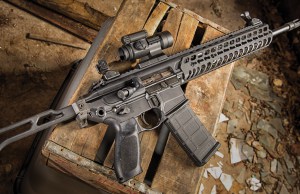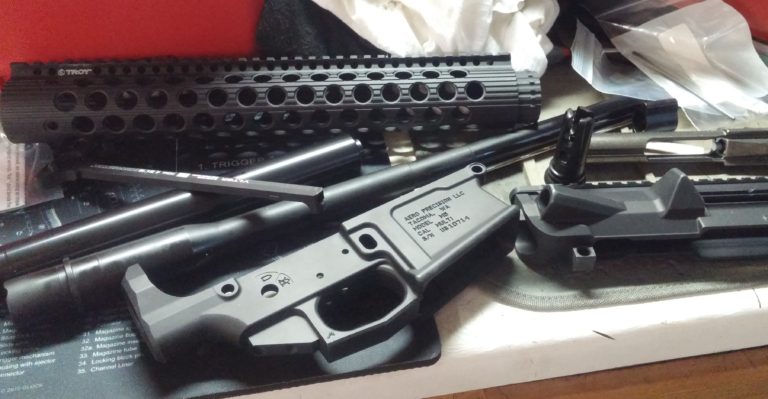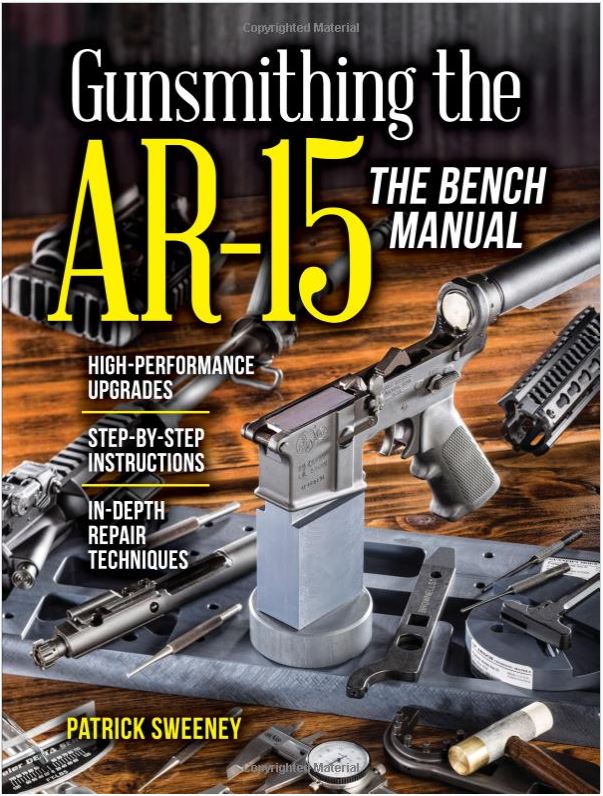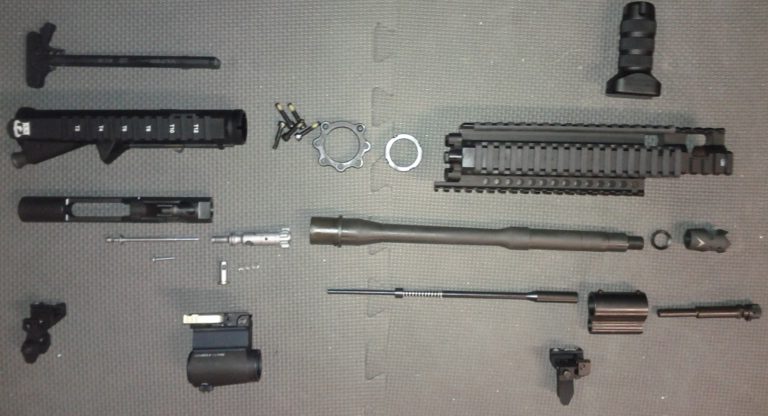
In the previous article, we discussed what gunsmithing is, and saw that it had three components, tools, knowledge and skills. We started out by looking at some of the universal basic tools of gunsmithing. In part two, after some final thoughts on tools, we’ll look at knowledge and skills needed in gunsmithing.
Other Tool Considerations
In most cases, a firearm will come with everything securely fastened in place. If you remove a screw which was “Loc-Tited” in place, you should have a little tube of Loctite on hand to allow you to refasten it. If a part is “staked” in place (surrounding metal is “mushed” into the part), don’t remove it unless you know what you are doing and have the appropriate staking tool.
A set of magnifying glasses or an Optivisor can help you see small details better, and safety glasses will ensure you can keep seeing anything. If lighting at your work station will be a problem, a small, bright “headlight” would be in order. I find the Bushnell headlamps to be small, light, very useful and dirt cheap.
So far we have discussed a good beginning set of general tools for testing, basic maintenance, disassembly and reassembly. If you get good quality tools and shop wisely, you should be able to get started for well under $400 (not including headspace gauges) and probably under $200 if you go with medium quality. As to “specialty” tools for each firearm you intend to work on, the trick is to have the ones you need and not waste money on ones for tasks or firearms which are not in your current plans.
If you are going to start changing things while you are inside the firearm, the general tool list gets bigger (and more expensive too). Here is a gunsmith tool set recommended by AGI, one of the better “distance” gunsmith schools, for a “professional” gunsmith. The video on the page has more information about the recommended tools than does the printed list and is interesting to watch.
All of the tools they include are “general purpose” tools, so their set does not include any specialized tools for particular models or classes of firearms, which is completely understandable. They don’t have a clue what firearms you will work on or what procedures you will do. I think the $2000 estimate mentioned is quite low if you get good quality tools (some of the ones they show look like they could have come from a “bargain bin”), and if you add specialized tools, the total tends to really zoom upwards. In case you were wondering what the top end training package which includes all these tools as well as all the training runs, it is $15,000. But unless you are becoming a “professional” (when there are tax deductions and professional discounts available), you don’t need all these tools or education to begin with. Get the basics, and add the other items as you need them.
Some of the tools you can get from common tool sources, or Amazon or eBay. For some of the more esoteric ones you will probably have to go to a gunsmith tool supplier. Brownells used to be the standard for gunsmith tools, and they are still around today, although the ratings of some of their tools seem to indicate the quality of some items may have declined. I really don’t know of another “go to” place for specialty tools, although many of the standard tools and a few specialty tools are available from online firearms stores such as Midway or Optics Planet, or my new favorite, Primary Arms. Let your fingers do the walking through the internet.
It is a good idea to have a specific container and location for your gunsmithing tools. If you mix them in with your “regular” tools, you will tend to use them for non-gunsmithing tasks, and they can get scattered or worn out early. If your set is fairly small, a portable tool case or pouch may do. For a medium-sized set, a multi-drawer toolbox or two is just the ticket. I used a four drawer toolbox for assembly, disassembly, lubrication, adjustment and measuring tools and supplies, and a three drawer one with tools and supplies for making modifications, which worked out perfectly for my needs and still could be carried in one trip. For a large or professional set, you want a room or part of a room, with workbench, power tool stands, peg board and tool drawer systems.
Knowledge
This one is tricky. For convenience, we divide this into “general” and “specific”. General knowledge is the “basics”; including types of firearms and how each type works (or is supposed to work), basic tools and their usage, “universal” disassembly, reassembly and minor modifications. This will be covered in a good gunsmithing curriculum, or you can get a good handle on this from books, internet articles and online videos.
“Specific” knowledge is knowledge some of which you don’t need – until you do. For instance, details of a specific model firearm you don’t have any immediate plans to work on or a specific procedure which you don’t currently plan to perform. Since it is somewhat impractical to learn it all (and remember it 10 years later when you finally need it), generally this is best covered (or relearned) by reference books (paper or online) which you refer to as needed. If you plan to specialize (use some specific knowledge a lot), then learning that subset of specific knowledge would seem the only practical methodology. In this case, you may be able to get it from self-study, or you may be better served going to classes in that area of study.
For classes in gunsmithing, there are a number of possibilities. If you have a local gunsmithing school or junior college/trade school/specialty school which offers courses, that may be a viable option. It will be expensive and probably take up to two years for a degree, although a “certificate” may be a shorter time option. If you don’t have live classes locally, then generally attending classes “away” is not practical, since not only are there the tuition costs, but lodging and other expenses. Not to mention existing and temporary employment. In the “old days”, they had mail order courses, which have been replaced with online training and DVD based training. If you can keep engaged, some can provide INFORMATION as well as or even better than local “live” classes (you can repeat something as many times as you need), but there are some severe weaknesses. Many of these don’t have a method for you to get questions answered, and none provide guided “hands-on” experience.
As a point for comparison, AGI’s basic “108 hour” video course is about $5000. On the other hand, Phoenix State University claims their online training is “the best and quickest and cheapest”, at $99 for the basic certification, $149 for the intermediate one and $199 for the top one. I’ve always heard that “if it sounds too good to be true, it probably is not true”, and that seems to be the case with PSU, based on the huge number of similar complaints (them not providing what was promised and using delaying tactics until the grace period for a refund has expired) I found about them. A legitimate online course seems to run about $1500.
The instructions which come with specialized tools you buy is “knowledge”. As a hint, store them in a good location. When I dusted off my set, I found that I had forgotten not only how to use some of the specialized tools, but even what they were for. If the instructions had not been in one of the drawers of the toolbox, I might still be trying to figure a couple of them out.
Skills
“Skill” is the difference between “knowing how to do something” and “being able to do it”. If you have a fair amount of mechanical experience, you might be able to become competent at many gunsmithing skills fairly quickly through trial and error. If you are not mechanically-minded, you will likely need to be shown how to do something, and then practice it. The best place for this is gunsmith classes which have guided “laboratory” sessions. If you have a school locally, at a reasonable price, you are lucky. Otherwise, online or video classes may be able to show you what to do, but you won’t be able to do it until you have done it, and that may take someone who has done it before watching over your shoulder or even guiding your hands. You may be able to find a local gunsmith who will work with you; perhaps even set up an apprentice relationship.
The other option is just to try things on your own. Here’s a hint: the first time you try something, don’t try it on an expensive firearm or critical firearm part… In fact, go to gun shows and get the cheapest beaters you can find, even non-working or partial ones, to practice on. To learn skills, videos are often better than written descriptions; being set up in front of the TV screen is about as close as you can get to a live expert present.
To be clear, there is no “distance” course which can provide you skills. The best ones can guide you in attaining the skills on your own.
Parts
A functioning firearm generally has all the parts it needs included. But parts break or wear out. And if you take the firearm apart, small parts can get lost. Sometimes stock parts are sub-standard, such as the MIM (Metal Injection Molded) extractor in modern Remington 870s replacing the machined part in older production. Many aftermarket companies put out parts which are easier to use, more accurate, more durable or just cooler looking. Improving the functionality of a firearm, such as replacing the safety with an extended version, is often wise. For disaster planning, having some spares for firearm parts which are at risk of breaking or loss is wise. Things like a firing pin, extractor, and springs and pins seem a good choice, and usually are not terribly costly. Some sources even have gathered together a set of parts in an “Oops Kit”.
Gunsmithing, Why Bother?
You may have noticed that I am suggesting that you spend money on tools and possibly education, and perhaps worse, a significant amount of time. Presumably you are already spending money on getting survival supplies and time learning survival skills; I’m not saying this is MORE important than any other skill or equipment. But if you plan on relying on firearms in a crisis situation, you had better be able to keep them working, and if one happens to stop working (or if you come across one which is not working), get it working again. It might even save you money in the long run if you don’t have to always go running to an expensive gunsmith when a firearm needs repair or modifications for optimal utility. It can be a source of extra income or an alternate career. Even if you can’t see gunsmithing as a worthwhile part of your personal survival plans, remember that gunsmithing will be a “primitive profession” which will have a lot of value in bartering in a post apocalypse world.























